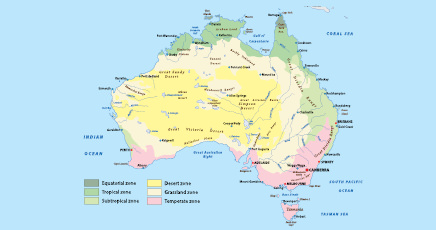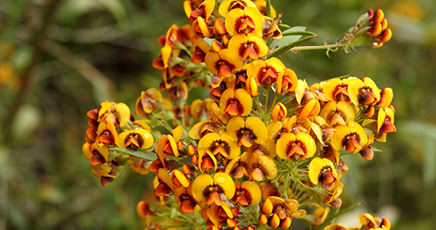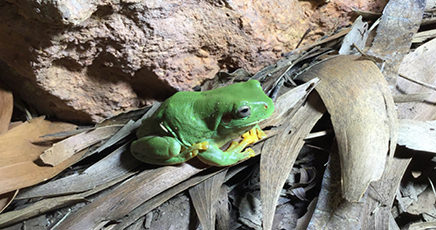STORY
The children needed to learn that they have to provide access to food and shelter to the wildlife they want to attract. Suyin asked her teacher if she could invite her Grandad to talk about the importance of native plants to native wildlife. Grandad knew a lot about plants and animals, and has a great way of helping young people understand their important relationship.
The students learnt that it is important to plant a diversity of species to ensure that the animals have food all year. Grandad explained that it is important to understand the climate of your area to choose the right plants, so that will have the best chance of growing and surviving, and why it is important to plant them properly. Suyin was so proud that Grandad had so much information to share and the students were all eagerly listening.

Planting is an essential part of the project, enabling your planning and design to come to fruition. The Research, Vision and Design activities have provided you with all the information you need to plant a garden and create a wildlife habitat.
This learning activity is the fourth part of a sequence of 5 individual learning activities focused on creating a wildlife habitat. The order of these learning activities are: research, vision, design, planting and monitoring and care.
For children to:
- understand the steps involved in creating a wildlife garden and habitat
- look at planting a diversity of native plant species forms to support animals all year
- enjoy being active and productive outdoors and build their social and teamwork skills
- understand the importance of site selection.
Planting depends on your climate and the type of plants you want to use. In temperate Australia, Autumn is generally the best time, as it gives the plant time to grow its roots and establish itself before the hot Summer. During the warmer months (Spring and Summer and Autumn), it is recommended that you run this as a morning learning activity. This will help avoid heat stress for people and plants.
Introduction
Planting is a great way to learn about the importance of native plants in creating habitats. Children will learn about the best location and conditions for native plants. The planting stage is where the children will be applying the information discovered in the research, vision and design activities already undertaken in this sequence. This will help establish a garden that will provide food and shelter for local native animals all year round.
*Time allocation will be dependent on site selection, travel time and that site preparation has been completed. Additional time may be spent in consultation with your local Landcare group, council, or native plant nursery.
Checklist
Instructions
STEP 1
Plan
Use your wildlife habitat design to determine your site selection and how many plants you will need.
Walk around your site and mark out where you will plant the different types of native plants to create a multi-layered habitat. Consider and include:
- access to water
- maintenance access
- the location of animal habitats like a lizard lounge, nest box or insect hotel
- position spiky plants away from pathways
- Read any labels – plants will get bigger as they grow, so don’t plant them close together.
Plant during the cooler months when there is generally higher rainfall to reduce the need for watering.
STEP 2
Prepare
Have your site prepared and plants ready before planting.
Get the whole school involved in the site preparation.
- Ask Junior Landcare students or the gardening club to help prepare the site.
- Plan your school working bee around this project to get extra help preparing the site.
- Ask for donations of plants and mulch from local nurseries, councils nurseries and families from the school.
STEP 3
Planting
Once the plants are in their correct positions, dig a hole that is slightly deeper and wider than the pot. Water the hole in preparation for planting.
Make sure the hole is big enough to fit the plant and totally cover the roots.
Gently remove the plants from their pots ready for planting. It is best to have as little disturbance to the roots as possible. Keep the soil and plant intact by gently squeezing each side of the pot, then placing your hand flat over the soil with the stem between your fingers. This will provide the least amount of stress and disturbance to the plant during the process.
When you backfill the soil, leave a shallow ‘well’ to help catch rainwater, so water will stay longer and reach down to the roots.
Press the soil around the plant lightly, without packing it down to hard. Pressing too hard pushes out air which is needed by the roots.
STEP 4
Maintenance and upkeep
Your plants are in the ground, what’s next?
Mulching
Placing thick (between 7 to 10 cm deep) Eucalyptus mulch layer around your plants will keep the soil moist and cool, control weed growth and help maintain micro-organisms in the soil.
Mulch your native plants soon after you have planted and watered your plants in. Apply mulch as an evenly spread blanket on top of soil surface.
Wear a mask when spreading mulch.
Contact local councils or tree loppers about free eucalyptus mulch.
Roster
Using the Planting Activity Sheet, create a roster to share plant caring activities with your Junior Landcare team.
This can include watering, measuring growth, plant changes and checking mulch. You can also start making observations to see if any new native animals have arrived.
The more involvement and ongoing maintenance, the better the growth of your plants.
Extension Activity
Ask the students to research the traditional uses of the native plants you have selected in your wildlife habitat.
Ask your local Landcare group or local Traditional land owners to give a talk to your students about how to care for native plants.
Curriculum and Framework Links
SCIENCE
Year 3: ACSHE050, ACSIS053, ACSIS054, ACSIS057, ACSIS215, ACSIS060
Year 4: ACSSU075, ACSSU073, ACSIS064, ACSIS216, ACSIS071
Year 5: ACSSU043, ACSHE083, ACSIS231, ACSIS086, ACSIS090
Year 6: ACSSU094, ACSSU096, ACSHE098, ACSHE100, ACSIS221, ACSIS110
Year 7: ACSSU112, ACSSU116, ACSHE223, ACSHE120, ACSHE121, ACSIS125, ACSIS133
Year 8: ACSHE135, ACSHE136, ACSIS139, ACSIS145, ACSIS148
GEOGRAPHY
Year 7: ACHGK037, ACHGK038, ACHGK039, ACHGK040, ACHGK042, ACHGS050
Year 8: ACHGK051, ACHGK052, ACHGK053
HUMANITIES, ARTS & SOCIAL SCIENCES
Year 3: ACHASSK072
Year 5: ACHASSK114, ACHASSK118
HEALTH AND PHYSICAL EDUCATION
Year 3 & 4: ACPPS035, ACPPS038
Year 5 & 6: ACPPS056
Year 7 & 8: ACPPS073
ETHICAL UNDERSTANDING
Exploring values, rights and responsibilitie
PERSONAL AND SOCIAL CAPABILITY
Social awareness
CURRICULUM CONNECTIONS
Outdoor Learning
CROSS CURRICULUM PRIORITY
Sustainability
MY TIME, OUR PLACE: FRAMEWORK FOR SCHOOL AGE CARE
Outcome 2 and 4
Reference List
ONLINE RESOURCES
Find out more about Native plants with the Australian Native Plants society.
Sustainable Gardening Australia has a variety of articles on Habitat Gardening.
Birds in Backyards have some great tips for Growing a Native Garden, including soils and mulching.
The Australian Native Nursery shares their top tips for growing Australian native plants in your garden.
WATCH
Establishing Native Shrubs from Gardening Australia (5 minutes). This video provides information on plant selection and planting tips.
IMAGE ATTRIBUTION
Photo of green tree frog by Ollie B. (2020 What’s in your backyard challenge Top 100)
Photo of legless lizard by Jessie F. (2020 What’s in your backyard challenge Top 100)
Photo of lilly pilly by Cayleigh F. (2020 What’s in your backyard challenge Top 100)
Photo of lorikeet by Callum O. (2020 What’s in your backyard challenge Top 100)
We value your feedback
When you have finished this learning activity, please tell us what you think with our survey.
Your feedback will help Landcare Australia improve the activities in the Junior Landcare Learning Centre.
Why not try one of our other Junior Landcare learning activities?
Creating a butterfly garden
Biodiversity
Love Letters to the Land
Biodiversity|First Nations Perspectives|Food Production|Waste Management
Creating a sensory garden
Biodiversity
Understanding weeds: life cycle
Biodiversity


